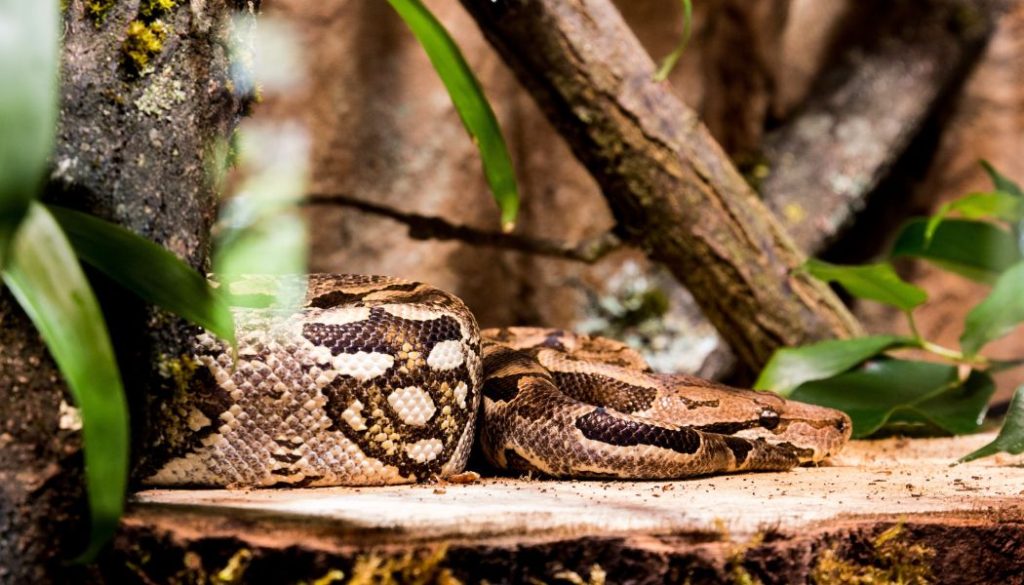Do red tail boas like to swim? The answer is a bit complex. While red tail boas can swim and are often found near water in their natural habitats, it’s not necessarily a recreational activity for them. They’re more opportunistic about water, using it for shedding or relieving skin irritations.
Ready to dive into the world of red tail boas and their relationship with water? You’re in the right place! We’re going to unravel the mystery of whether these fascinating reptiles like to swim, or if it’s all just a big, wet misunderstanding.
We’ll explore their natural habitats, their anatomy, and the nuances between swimming and soaking. Plus, tips on how to set up a safe swimming area for your boa and answers to some of your burning questions.
Get ready to get your feet wet—or should I say, your scales?

Table of Contents
- 1 Their Habitat: The Availability of Water in Their Natural Settings
- 2 The Anatomy of a Swimmer: Are Red Tail Boas Built for It?
- 3 Swimming vs. Soaking: What’s the Difference?
- 4 How to Safely Let Your Red-Tail Boa Swim
- 5 The Role of Swimming in Red-Tail Boa Health
- 6 Setting Up a Swimming Area: Tips and Precautions
- 7 Final Word
- 8 FAQ
Their Habitat: The Availability of Water in Their Natural Settings
Where Red Tail Boas Call Home
So, you’re curious about whether your red tail boa wants to be the next snake Michael Phelps, huh? First things first, let’s talk origins. These slithering wonders mainly come from Central and South America.
The Landscape They’re Used To
You’re probably visualizing lush rainforests, winding rivers, and all that greenery. And you wouldn’t be entirely off. Their natural habitat ranges from forests to semi-desert terrains.
Water Availability in Different Habitats
Here’s where it gets interesting. The availability of water in these settings varies. In forests, it’s like a water wonderland with rivers, ponds, and marshy areas. But in semi-desert conditions, water is more like a rare gem.
The Real Question: Are They Leisure Swimmers?
Let’s cut to the chase. Just because red tail boas can encounter water doesn’t mean they’re swimming laps for fun. These boas are opportunistic when it comes to water, taking advantage of it when necessary, like for hydration or shedding.
Why This Matters
Understanding their natural habitat is our gateway into the complex psyche of these fascinating reptiles. It’s our first clue in solving the age-old mystery: Do red tail boas actually like to swim? And trust me, you’ll want to stick around for the full scoop.
The Anatomy of a Swimmer: Are Red Tail Boas Built for It?
A Sneak Peek at Snake Anatomy
Okay, let’s talk body structure. At first glance, you might think, “A snake’s body is basically one long muscle, so they’ve got to be natural swimmers, right?” Well, hold your horses—or should I say, hold your snakes?
Are They Hydrodynamic?
Red tail boas aren’t exactly built like dolphins, but their elongated bodies and strong muscles do give them a sort of hydrodynamic advantage. When they swim, they move in a serpentine manner, much like how they slither on land.
Muscles and Movement
Their muscles aren’t just for show! These guys use their powerful muscles for propulsion, allowing them to navigate through water with a kind of grace you wouldn’t expect from a creature without fins or flippers.
To Float or Not to Float
However, red tail boas aren’t buoyant creatures. They don’t float well, which means swimming isn’t as effortless for them as it is for, say, a duck.
So, Built for Swimming or Not?
So, what’s the verdict? Well, they can swim, but they aren’t what you’d call “natural-born swimmers.” It’s more of a functional skill for them, not a leisure activity. Think of them as the folks who only go to the gym when they absolutely have to.
Swimming vs. Soaking: What’s the Difference?
The Soaking Phenomenon
You may have heard stories or even seen your red tail boa spending time in its water dish. This is commonly referred to as “soaking.” Now, soaking is not the same as swimming, even though both involve water.
Why Soak?
Soaking often occurs for various reasons: it can help with shedding, relieve skin irritations, or even help eliminate external parasites. It’s more of a therapeutic action than a recreational one.
What’s Considered Swimming?
Now, swimming involves more active movement. Your red tail boa will utilize its strong muscles to propel itself through water. This is usually more about getting from point A to point B, rather than simply enjoying a dip.
The Takeaway
In essence, soaking is like taking a long, hot bath after a stressful week, while swimming is more like running a sprint. Both involve water, but the intent and execution are as different as night and day.
How to Safely Let Your Red-Tail Boa Swim
First Things First: The Water Quality
You wouldn’t jump into a pool filled with dirty water, and your red-tail boa shouldn’t have to either. Make sure the water you’re using is dechlorinated and clean. Tap water can contain chemicals harmful to reptiles, so be mindful of that.
Water Depth: How Deep is Too Deep?
Okay, remember, these guys aren’t the Michael Phelps of the snake world. You’ll want to keep water depth to a reasonable level. A shallow pool—think a couple of inches deep—is generally a safe bet.
Water Temperature: The Goldilocks Principle
Not too hot, not too cold. You’re aiming for a water temperature close to the ambient temperature in your snake’s enclosure. Use a thermometer to be extra sure because guessing games and pet care don’t mix well.
Supervision: No Lifeguard on Duty
Always, and I mean always, supervise your snake while it’s swimming. Even though they can swim, they are not natural swimmers. Always better to be safe than sorry.
Signs of Stress: Know When to Pull the Plug
Keep an eye out for signs of stress or fatigue. If your boa starts acting jittery or tries to escape the water, it’s time to wrap up swim time. Trust me, your snake will thank you.
The Role of Swimming in Red-Tail Boa Health
The Pros: Can Swimming Be Beneficial?
Swimming can actually aid in the shedding process. It’s a bit like soaking, but with some added movement. This can make it easier for the old skin to slough off.
The Hydration Factor
Water immersion can also help keep your snake hydrated. Yes, they absorb water through their skin! It’s not a substitute for drinking, but it’s a bonus.
Parasite Problems: The Double-Edged Sword
Be cautious here. While swimming can help get rid of some external parasites, a contaminated water source can introduce new ones. It’s a bit of a gamble, so again, water quality is key.
When Swimming Isn’t a Good Idea
If your red-tail boa has any open wounds, skin infections, or seems generally unwell, skip the swim session. Water can exacerbate health issues, turning your fun snake swim day into a trip to the vet.
The Bottom Line: Exercise Caution
While swimming can offer some health benefits, it’s not a cure-all and it comes with its own set of risks. Like anything in life, moderation is key. Make sure to consult your vet for personalized advice tailored to your slithery friend’s needs.
Setting Up a Swimming Area: Tips and Precautions
The Container Conundrum: What to Use
First thing’s first: What are you going to use as a swimming area? An easy choice could be a large, shallow plastic container. Make sure it’s sturdy, and that your snake can’t easily tip it over.
Surface Material: Slippery When Wet
Let’s talk about the bottom surface. You don’t want something too slippery, as your snake may struggle to move around. At the same time, you don’t want a surface that’s too abrasive. Aim for a happy medium, like a textured but not sharp bottom.
Creating Boundaries: Keep It Contained
Think about adding some kind of barrier or lid with air holes. Red-tail boas are curious creatures, and you don’t want yours making a break for it mid-swim.
Filtration: Keep It Clean
If you’re thinking about making the swimming area a more permanent fixture, consider adding a filter to keep the water clean. Trust me, both you and your snake will appreciate this in the long run.
Test Run: The Dry Rehearsal
Before you introduce your red-tail boa to its new swimming digs, let it explore the area dry first. This helps your snake become familiar with the space, making the actual swimming experience less stressful.
Safety First: Have an Exit Strategy
Always have a plan for how you’re going to get your snake out of the water quickly if needed. Whether it’s a snake hook or a gloved hand, know your exit strategy.
Setting up a swimming area for your red-tail boa is more than just filling a container with water and calling it a day. It’s about creating a safe, comfortable environment where your snake can explore the water in the best way possible. After all, if we’re going to do this, let’s do it right!
Final Word
You’ve learned that while they can swim, it’s usually more about necessity than leisure. Their natural habitats and anatomy give them the tools they need to navigate water when they have to.
You even know how to set up a safe swimming space for your scaly friend. It’s fascinating, isn’t it? The more you know about these incredible creatures, the better you can care for them.
So go ahead, put your newfound knowledge to good use and enjoy your time with your red tail boa!
FAQ
Do Red Tail Boas Like Water?
Well, “like” might be a strong word, but they can definitely use water for various purposes. They’ll often soak for shedding or to relieve skin irritations. While they can swim, it’s usually more about function than fun.
What Do Boas Like in Their Cage?
When it comes to cage setup, think comfort and utility. They love climbing branches, dark hiding spots, and of course, a water dish for hydration and occasional soaking. Make sure you have a heat gradient and good ventilation too.
How Often Do Boas Need Water?
These guys should always have access to clean, fresh water for drinking. As for swimming or soaking, it’s less about need and more about specific circumstances like shedding or health concerns. It’s not a daily or even weekly requirement but can be beneficial under the right conditions.




0 Comments